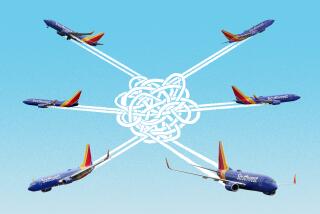Pacific Turbulence : Economic Woes Are Forcing Many Asian Airlines to Buckle Up
- Share via
MANILA — The high-flying days of Asian aviation are over for the foreseeable future as the region’s economic crisis ripples through airlines and plane makers around the world.
Until the crisis struck last summer, Southeast Asia was the world’s fastest-growing aviation market. Singapore and Bangkok were thriving as major international hubs, and destinations from Manila to Hanoi enjoyed tourism and commercial booms.
But the tourist industry--much of it generated by Asians visiting neighboring countries--fell sharply as families began watching their rupiahs and baht. At the same time, political instability in Indonesia and Cambodia brought tourism to a standstill, and the economic downturn across Asia slowed the flood of business travelers to a trickle.
The hardest hit have been Asia’s regional carriers, which have responded by laying off employees, cutting back on flights, restructuring routes and offering bargain fares to fill empty seats.
One small Indonesian airline has already shut down and at least two others, including Philippine Airlines (PAL), say they might have to declare bankruptcy.
Asian airlines accustomed to operating in a time of plenty are under increased pressure to trim costs and increase efficiency without sacrificing the personal service that has pushed them to the top of the travelers’ preferred list year after year.
“When this is all said and done, this is going to be a different marketplace than it’s ever been before,” said Gus Whitcomb, a spokesman for Hong Kong-based Cathay Pacific Airways, one of the region’s leading carriers. “But Asian airlines, for as long as anybody can remember, have been known for their service. We can’t afford to let our service go.”
Asia’s travel slump is also cutting into the profit margins of some of the world’s largest airlines and aerospace manufacturers. Northwest Airlines, which depends on the Asia-Pacific region for 35% of its revenue, warned recently that its second-quarter earnings will be depressed by the Asia slump.
And Boeing Co., which sells 20% of its planes to Asia, now predicts it will sell 150 fewer planes over the next five years as a result of the industry turmoil. Carie Cable, a Boeing spokeswoman, said Friday the manufacturer has not had any Asian airlines cancel orders and has had fewer than 60 aircraft deliveries delayed during the next two years. She said the company has been able to find new customers for many of those planes, largely from Europe.
Adam Pilarski at Reston, Va.-based Avitas, an aviation consulting firm, said the resulting glut of new and used planes on the market has stepped up the pricing war between Boeing and its primary competitor, Airbus Industrie, a European consortium, particularly on the expensive jumbo jets used on the long-distance routes in Asia.
The only ones certain to benefit from Asia’s aviation woes are travelers who have seen price wars slash the cost of a trans-Pacific round-trip economy ticket to as low as $500.
It could also create opportunities for the strongest players in the Asian market--which include Northwest, United Airlines, Singapore Airlines and Japan Airlines--to pick up some cheap planes or expand their presence through acquisitions and alliances.
While traffic growth in Asia is now expected to be flat or even fall this year and possibly next, aviation experts still believe the region’s economies will rebound and it will regain its position as the world’s fastest-growing market.
Analysts expect strong resistance from Asian governments to selling off even a portion of a national flag carrier to foreigners because it would represent a sharp blow to national pride.
But for a carrier such as PAL there are few choices. PAL, which lost $200 million last year, is teetering on the edge of bankruptcy as the result of a pilots’ strike, the economic slowdown and a long history of corporate infighting and poor management.
PAL reportedly has approached Northwest, Lufthansa and British Airways for an infusion of cash. Jon Austin, a Northwest spokesman, said Friday his airline is looking for new “opportunities” in Asia but wouldn’t comment on any discussions with PAL.
“There are opportunities out there, whether . . . in the area of alliances or aircraft acquisitions,” Austin said.
PAL, the oldest carrier in Southeast Asia, is running out of time. The airline is entering the second week of a strike by 600 pilots protesting a policy of mandatory retirement after 20,000 hours of flying or 20 years of service. On Wednesday the airline fired the pilots and it is now operating on a limited basis with 25 management pilots.
Less than a year ago PAL’s board of directors announced a $4-billion modernization program and ordered 36 new aircraft. But Asia’s currency crisis sharply reduced passenger loads and left the company with a bloated debt because most of its revenue is in Philippine pesos and much of its expenses in hard currency. The peso has lost 40% of its value in the last year.
Similar tales are cropping up elsewhere in the region. In Jakarta, Indonesia, this week, spokesmen for Garuda Indonesia, the national carrier, said the airline is facing bankruptcy. Its debt has climbed to $200 million--half of it due now--and officials told parliament that without restructuring, Garuda planes that fly overseas “will be confiscated.”
Another Indonesian airline, Sempati, controlled by the family of former President Suharto, closed last month after mounting losses. It had an extensive domestic network.
But some Asian airlines with routes to the U.S. and Europe are expanding. Singapore Airlines recently added direct service from Newark, N.J., to Singapore. Cathay, although cutting flights in Asia, is boosting its direct service to London; Sydney, Australia; and Los Angeles.
Cathay’s management intends to shore up its weak spots and better position itself for Asia’s comeback, according to Whitcomb.
“Everybody is saying, Asia is going to rebound and our management is certainly placing its bets on that,” he said. “Whether it’s one year from now or later, we want to be the airline best positioned to capitalize on that.”
*
Lamb reported from Manila and Iritani from Los Angeles.
(BEGIN TEXT OF INFOBOX / INFOGRAPHIC)
Hard Landing
Continuing economic turmoil in Asia has hit the airline industry hard. Percentage change from first-quarter 1997 to first-quarter 1998 in passengers traveling from certain Asian countries to the U.S.:
Country: Change
Indonesia: --21.00%
South Korea: --23.00%
Malaysia: --23.60%
Philippines: --14.20%
Singapore: +0.01
Sources: International Air Transport Assn., International Trade Administration
Researched by JENNIFER OLDHAM / Los Angeles Times
More to Read
Inside the business of entertainment
The Wide Shot brings you news, analysis and insights on everything from streaming wars to production — and what it all means for the future.
You may occasionally receive promotional content from the Los Angeles Times.










